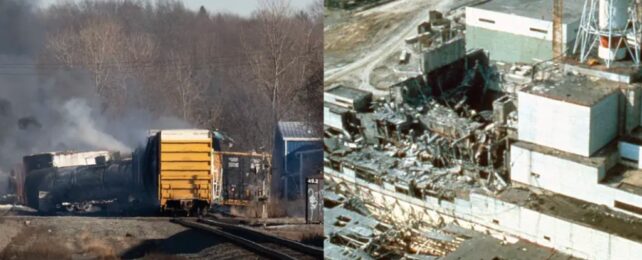Following the February 3 train derailment in East Palestine, Ohio, users on social media began sharing photos of an ominous black cloud hanging over the town – and fears that the disaster would become the new Chernobyl.
A fire engulfed a Norfolk Southern train after 50 of its 150 cars derailed. The train carried 10 cars full of hazardous materials, including vinyl chloride, a colorless gas used in the creation of the plastic PVC, which was released as a result of the derailment. In sunlight, it can be broken down into chemicals like formaldehyde.
Other flammable chemicals, like ethylene glycol monobutyl ether, ethylhexyl acrylate, butyl acrylate, and isobutylene were also present in the cars and released into the environment, according to a list compiled by the EPA.
Many of these chemicals are carcinogenic or potentially carcinogenic, or are considered respiratory and eye irritants.
The toxicity of these chemicals initially prompted concerns about the health and safety of residents. Then came the comparisons to another disaster, one that happened nearly 40 years ago: The nuclear disaster in the city of Pripyat on April 26, 1986, which resulted in the spread of radioactive contaminants in Ukraine and across Europe.
Although the intense imagery from Ohio might have onlookers believe the state has a mini Chernobyl on its hands, the scale of Chernobyl's destruction was much worse. However, the environmental impact of the East Palestine incident should not be ignored, experts say.
Chemicals released during both disasters were carcinogenic, but Chernobyl was radioactive
The Chernobyl incident occurred after a series of safety measures during a nuclear reactor test were ignored, resulting in a huge explosion and fire that spread large amounts of radioactive chemicals like plutonium, iodine, strontium, and cesium.
Although carcinogenic chemicals were found on the train in East Palestine, and multiple small explosions occurred following the derailment, many were burned in a controlled fashion – which resulted in the large black cloud over the city. The chemicals in the East Palestine incident are also not as potent as the nuclear waste in Chernobyl.
Nobody died as a result of the East Palestine chemical spill
Two people died immediately following the explosion at Chernobyl. A month later, nearly 30 emergency workers died as a result of acute radiation sickness and one of cardiac arrest. Following the accident, it's estimated that thousands may have died as a result of cancers and blood diseases caused by chemical exposure from the Chernobyl power plant – although these figures are still being disputed.
In East Palestine, no deaths have been reported as a result of the derailment or the following fires and explosions, although residents say they are experiencing respiratory issues, sore throats, irritated eyes, headaches, and other ailments.
Multiple class action lawsuits have been filed against Norfolk Southern Railroad Company following the derailment, with residents saying that the company should be responsible for the health effects to residents and the environment.
There have been reports of a significant amount of animal deaths
Following the controlled burn of chemicals to prevent a deadly explosion, residents say foxes, chickens, and other domesticated animals have died. There have also been approximately 3,500 dead fish counted in four nearby waterways, the Ohio Department of Natural Resources said Tuesday.
In Chernobyl, the effects on animal life have not been fully determined. The explosion had immediate effects on the health of animal populations and many plants and animals mutated as a result of radioactive exposure, according to the International Atomic Energy Agency.
East Palestine resulted in an evacuation, but it was short-lived
After the derailment, close to 2,000 residents in East Palestine were asked to evacuate.
Prior to the controlled burn in the Ohio city, the evacuation area was extended to a 2-mile-wide radius zone that was established on February 6.
On February 8, officials announced that residents could return to their homes after the EPA determined that it did not detect contaminants at "levels of concern" in air and water samples. The Ohio EPA also announced that it would monitor soil for potential groundwater leaching of chemicals, WESA reported.
But Chernobyl is still considered uninhabitable
The Chernobyl explosion contaminated 150,000 square kilometers in Belarus, Russia, and Ukraine, and resulted in the evacuation of around 350,000 people who had to leave all their belongings behind. A 19-mile-radius nuclear exclusion zone was established around the power plant that still exists today.
During the war in Ukraine, Russian troops returned to the Chernobyl plant and began digging trenches around the area. Ukraine's state nuclear agency claimed in March that Russians suffered "significant doses of radiation." Russian soldiers later left the plant in a state of disarray, Ukrainian workers said in June.
Hundreds of mostly elderly people have also returned to the zone – or never left – to live the rest of their lives in their hometowns.
"Those who left are worse off now," one woman said in the documentary Babushkas of Chernobyl.
"They are all dying of sadness."
This article was originally published by Business Insider.
More from Business Insider: